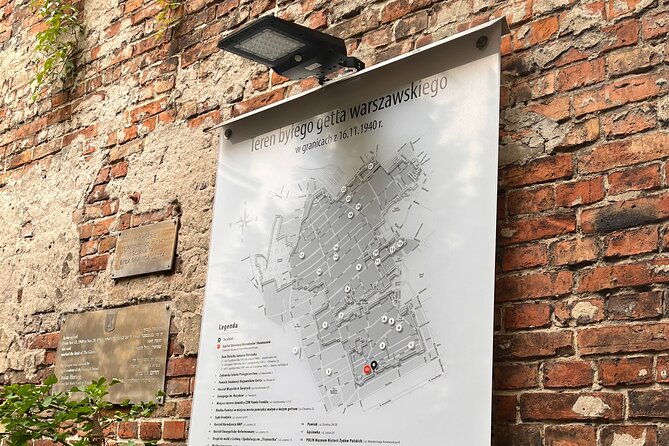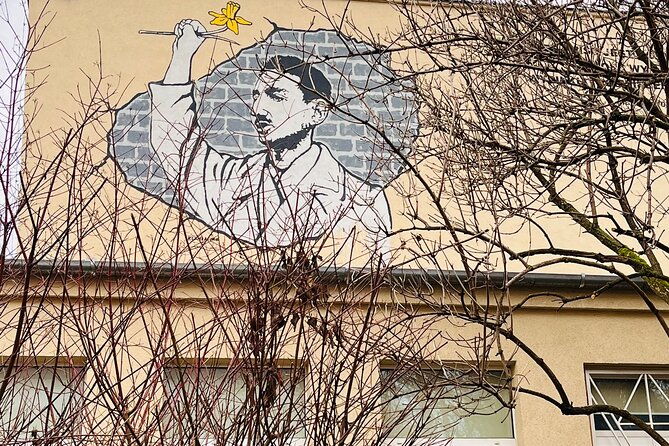Warsaw’s Jewish Ghetto has a captivating history that’s both tragic and resilient. Today, visitors can explore the remnants of this dark past while also discovering the vibrant Jewish culture that’s being revived in the area. As they walk along the crumbling Ghetto Wall, they’ll reflect on the courageous uprising and the enduring spirit of the Jewish community. But the true story lies in how the past and present now intertwine, revealing a complex and thought-provoking narrative.
Key Points

- The Warsaw Ghetto’s tragic history is preserved through landmarks and memorials, honoring the resilience and courage of its Jewish inhabitants.
- Guided tours provide insights into the ghetto’s daily life, the Warsaw Ghetto Uprising, and the enduring impact of Jewish culture.
- Contemporary Jewish community in Warsaw maintains vibrant traditions, offering visitors opportunities to engage with religious, educational, and cultural activities.
- Remnants of the past, such as the crumbling Ghetto Wall and Umschlagplatz memorial, serve as reminders of the Jewish community’s resilience under Nazi oppression.
- The exploration of Warsaw’s Jewish Ghetto reflects the interplay between the harrowing past and the ongoing efforts to preserve and revitalize the community’s legacy.
Exploring the Tragic History of the Warsaw Ghetto
Although the Warsaw Ghetto no longer physically exists, its haunting legacy remains etched in the collective memory of the Polish capital.
From 1940 to 1943, the Nazis confined over 400,000 Jews in a sealed-off district of the city, subjecting them to horrific living conditions, starvation, and disease.
The infamous Warsaw Ghetto Uprising, where Jewish fighters bravely resisted the German forces, was a last-ditch effort to fight against the Nazis’ genocidal plans.
The Warsaw Ghetto Uprising was a last-ditch effort by Jewish fighters to resist the Nazis’ genocidal plans.
Today, somber memorials and restored buildings stand as poignant reminders of this dark chapter in history, a testament to the resilience and courage of the Jewish people.
Looking for more options in Warsaw? We've reviewed plenty of other experiences.
Remembering the Courageous Uprising

The Warsaw Ghetto Uprising stands as a poignant symbol of the Jewish people’s resolve to resist the Nazis’ genocidal plans. For 27 days in 1943, the outgunned and outnumbered Jewish fighters fought back against the German forces. Their bravery, though ultimately crushed, serves as a testament to the human spirit.
The uprising included:
-
Homemade bombs and Molotov cocktails used to ambush German soldiers.
-
Barricades constructed from furniture and debris to slow the German advance.
-
Courageous last stands by fighters on the rooftops and in the sewers.
-
The burning of the ghetto to the ground as the Nazis sought to erase its very existence.
Discovering Remnants of the Past
Where remnants of the Warsaw Ghetto‘s haunting past still linger, visitors can uncover the stories etched into its walls and cobblestones.
The tour explores historic landmarks – from the Ghetto Wall‘s crumbling bricks to the Umschlagplatz memorial, where tens of thousands were deported to the Nazi death camps.
Guides share insights about daily life in the Ghetto, the courageous Uprising, and the ongoing efforts to preserve this complex history.
As the tour winds through the neighborhood, travelers gain a deeper understanding of the resilience and tragedy that defined the Jewish community‘s experience under Nazi occupation.
Walking in the Footsteps of Holocaust Survivors
As visitors follow the guide’s lead, they walk in the footsteps of those who endured the horrors of the Warsaw Ghetto.
The tour weaves through the former ghetto boundaries, where:
-
Remnants of the ghetto wall stand as a somber reminder.
-
Houses and buildings bear witness to the unspeakable suffering.
-
Plaques and memorials honor the memory of those who perished.
-
The silence is palpable, a reverent hush that commands reflection.
The guide’s expertise brings the past to life, sharing personal stories and historical insights that deepen the audience’s understanding of this profound chapter in Poland’s history.
Glimpsing the Vibrant Jewish Culture
Amidst the somber reminders of the Warsaw Ghetto’s tragic past, the tour also unveils glimpses of the vibrant Jewish culture that once thrived within its boundaries.
Visitors learn about the rich spiritual, intellectual, and artistic heritage that defined the former enclave. They discover Jewish customs, traditions, and architecture that continue to resonate today.
The tour guide shares captivating anecdotes about the ghetto’s pre-war residents and their unwavering resilience in the face of Nazi oppression.
This multifaceted exploration offers a more complete understanding of the Jewish community’s profound impact, even as its physical remnants bear witness to unimaginable cruelty.
Reflecting on the City’s Resilience
Though the scars of the Warsaw Ghetto’s destruction linger, the city’s resilience shines through.
As visitors walk the streets, they see:
-
Restored buildings that stand as testaments to Warsaw’s determination.
-
A memorial park honoring the courageous uprising, a poignant reminder of the city’s strength.
-
Bustling cafes and shops, symbols of the community’s revitalization.
-
Vibrant cultural events celebrating the enduring spirit of Warsaw’s Jewish heritage.
This resilience inspires awe, reminding all who visit that even in the face of unimaginable tragedy, the human spirit can prevail.
Connecting With the Present-Day Jewish Community
Visitors to Warsaw’s Jewish Ghetto can connect with the present-day Jewish community by engaging with the vibrant cultural activities and institutions that have emerged in the area.
Jewish heritage tours, Holocaust memorials, and synagogues offer opportunities to learn about the community’s resilience and continuity. Visitors can attend weekly Shabbat services, explore kosher eateries, and browse Judaica shops.
Community centers host lectures, concerts, and language classes, fostering connections between past and present. Through these meaningful encounters, travelers gain a deeper understanding of Warsaw’s enduring Jewish spirit and its path toward healing and renewal.
The meeting point for the tour is the Monument of Juliusz Słowacki in Plac Bankowy, an easily accessible location right in the heart of Warsaw’s city center.
The tour begins at the Monument of Juliusz Słowacki in Plac Bankowy, conveniently situated in the heart of Warsaw’s city center.
From there, the tour takes participants on a journey through the former Jewish Ghetto, ending at Willy Brandt Square. Along the way, the guide provides insights and recommendations:
-
Coffee or tea is included, with suggestions for nearby cafes to enjoy after the tour.
-
The tour is stroller-accessible and near public transportation, making it convenient for families.
-
Service animals are welcome.
-
However, the tour isn’t recommended for those with mobility issues or serious medical conditions.
More Private Tours in Warsaw
- Warsaw Private Bike Tour with lunch: Royal,Old Town,Lazienki
- Warsaw: Guided Walking Tour with a Private Chopin Concert
- Warsaw: Rembrandts Masterpieces – Royal Castle Private Tour
- Warsaw: Private River Cruise with Snacks & Drinks
- Ghost stories of Warsaw Night Private Tour
- Warsaw and Zelazowa Wola: Frédéric Chopin Private Tour
More Boat Tours & Cruises in Warsaw
- Warsaw: Vistula River Cruise on a Modern Barge
- Warsaw: Private River Cruise with Snacks & Drinks
- Warsaw: Old Town Walking Tour with Vistula River Cruise
- Warsaw: Cruise the Vistula w/ 80s Music, Retro Vibes & Views
- Warsaw: Sunset Vistula Cruise – 80s Vibes, Music & Prosecco
- Warsaw: Private Gondola Cruise for Special Occasions
More Tour Reviews in Warsaw
- Warsaw Private Bike Tour with lunch: Royal,Old Town,Lazienki
- Warsaw: Vistula River Cruise on a Modern Barge
- Warsaw: Guided Walking Tour with a Private Chopin Concert
- Warsaw: Visit a world of fairy tales and adventures – family
- Eco Bike Tour of Warsaw Old Town, Top Sights and Nature
- Warsaw: Night Street Photography Tour
Still browsing? Here are more Warsaw experiences we've covered recently
- The 12 Top Walking Tours In Warsaw: Which Is Best?
- Which Warsaw Tours To Choose? Our Best 14 Picks
- The 11 Most Popular Cruises And Boat Tours In Warsaw
- 14 Top-Rated Warsaw Tours & Experiences
- Warsaw’s 5 Best Food Tours (With Prices & Reviews)
- You’ll Love These 3 Photography Experiences In Warsaw
- Warsaw’s 4 Top Drinking Tours
- Warsaw’s 7 Top Historical Tours
- 5 Best Concert Experiences In Warsaw
- The 7 Most Popular City Tours In Warsaw
- Discover 6 Great Bike Tours In Warsaw
- The 7 Most Popular 3-Hour Tours In Warsaw
